Exploring the knowledge, attitudes, and behaviour of the general public to responding to out-of-hospital cardiac arrest
Exploring the knowledge, attitudes, and behaviour of the general public in relation to responding to out-of-hospital cardiac arrest
Chapter 2 Results from the Survey
Respondents were asked a total of 12 questions, focusing on two key elements - CPR training and administering CPR. Key elements of the former were questions on respondents trained in CPR, along with when and why they were trained. For those not trained, questions were asked to ascertain the reasons for this and assess whether they would take up CPR training given the opportunity. In addition, data were collected on experience of administering CPR, as well as exploring the perceived barriers to administering CPR and public attitudes towards administering CPR.
2.1 CPR training
Table 2 presents findings on CPR training. Over half of respondents were trained in CPR (52%), with an even gender split (53% of men compared with 52% of women). There was significant variation by:
- Age – the likelihood of being trained in CPR decreased with age. For example 35% of respondents aged 65 and over were trained in CPR in comparison with 60% of respondents aged 35-44.
- Social grade – people in professional, managerial and non-manual occupations (according to the household’s main income earner’s occupation) were more likely than those in manual, unskilled occupations and long-term unemployed people to be to be CPR trained (57% (ABC1) compared with 48% (C2DE), p<0.01.) and be more confident to administer CPR if talked through by a call handler (86% compared with 78%, p<0.001).
- Working status - employed respondents were more likely to be CPR trained (59% compared with 45% not employed, p<0.001).
Table 2: CPR Training
| Base = 1027 | CPR trained | Not CPR trained/ don’t know | P |
| Whole sample | 52% | 48% | N/A |
| Gender | |||
| Male | 53% | 47% | |
| Female | 52% | 49% | |
| Age | <.001 | ||
| 16-17[8] | [46%] | [54%] | |
| 18-24 | 54% | 46% | |
| 25-34 | 59% | 41% | |
| 35-44 | 60% | 40% | |
| 45-54 | 56% | 44% | |
| 55-64 | 55% | 45% | |
| 65+ | 35% | 65% | |
| Social Grade | <.01 | ||
| ABC1 | 57% | 43% | |
| C2DE | 48% | 52% | |
| Working status | <.001 | ||
| Working | 59% | 41% | |
| Not working | 45% | 55% | |
2.1.1 Delivery of CPR training
Those who had been trained in CPR were asked how they received their CPR training (Figure 1). More than two-thirds (67%) of those trained in CPR had been required to have CPR training as part of their employment (39%) or were offered training through their employment (28%). A further 11% had opted to take training through their voluntary work. Employment or voluntary work related training therefore accounted for a majority of those trained in CPR (78%).
12% of respondents received their CPR training through school and this varied by age. For example for those CPR trained, 16-24 year olds were the group most likely to have been trained in schools (47% of 16 -24 year olds compared with 6% of respondents aged 25 and over, p<0.001). More people in C2DE than ABC1 social grades had received training in school (16% of C2DE compared with 9% of ABC1, p<0.05) as had those not in employment compared to those in employment (16% compared with 10%, p<0.05). Despite caution required around the small sample size (just 64 respondents had been trained through school) these findings may in part reflect activities such as the October 2014 launch of the British Heart Foundation’s ‘Creating a Nation of Lifesavers’ initiative to target CPR training in schools in priority areas across the UK.[9] 10% of respondents had organised training themselves or were taught by a family member or friend. It is interesting to note that social grade groups C2DE were more likely to do this (11% compared with 7% in social grade ABC1, p<0.05) as were respondents who were not in employment (13% compared with 6% who were in employment, p<0.01).
Figure 1: How CPR training received (n=506)
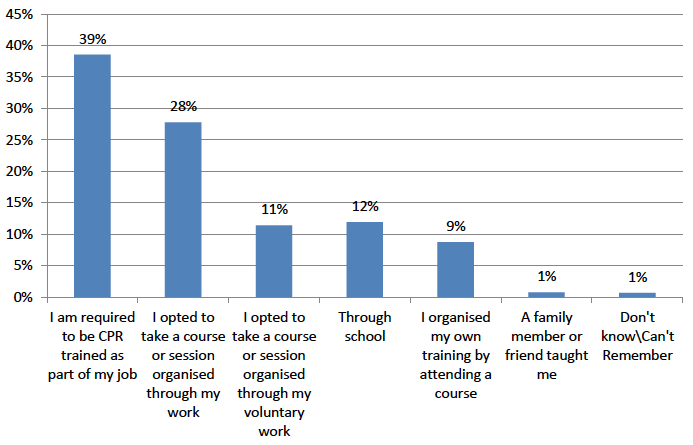
2.1.2 Time elapsed since CPR training
Figure 2 presents data on when respondents were CPR trained. Over two fifths were trained more than 5 years ago (44%), with the median (i.e. the middle range) more than 2 years but less than 5 years. However medians varied by:
- Age - the older a respondent was the more likely they were to have been CPR trained more than 5 years ago (p<0.001). For example, the median response for 16 - 34 year olds was more than one year but less than 2 years, for 35-54 year olds it was more than 2 years but less than 5 years and for respondents aged 55 and older was more than 5 years.
- Working status – respondents were more likely to have been CPR trained more recently if they were working (p<0.001). The median response for non-working was more than 5 years and the median response for working was more than one year but less than 2 years.
- Location - respondents living in a rural location were more likely to have median response of being CPR trained more than 5 years ago in comparison to the median for respondents living in an urban or conurbation location which each had medians of more than 2 years but less than 5 years ago (p<0.01).
Figure 2: When CPR trained (n=506)
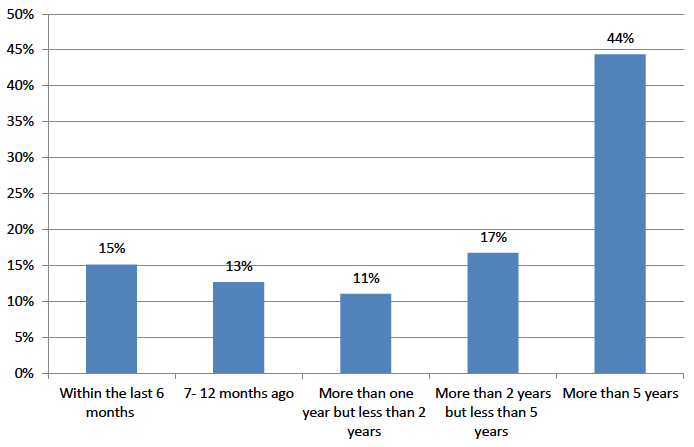
2.1.3 Attitudes towards CPR training
Over two fifths (42%) of respondents who had not been CPR trained said it was something they would like to do. Age and employment status were associated with people’s expressed willingness to become CPR trained. A smaller proportion of older people reported wanting to be CPR trained. For example, Figure 3 shows that 23% of respondents aged 65 would like to be CPR trained in comparison with 58% of 35-44 year olds (p<0.001). Those in employment were more likely to want to be trained than those who were not (53% compared with 33%, p<0.001). The main reasons respondents gave for not being CPR trained were because the thought had never occurred to them (28%) or they had not been given the opportunity (29%).
Figure 3: Would like to be CPR trained, by age (n=521)
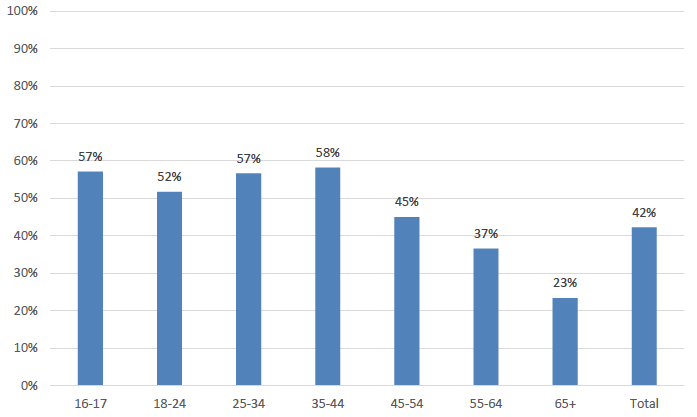
2.2 Administering CPR
One fifth (21%) of respondents would not know if CPR was required and half (50%) would not be confident to administer CPR. As shown in Table 3, levels of confidence to administer CPR were influenced by:
- Age - respondents aged 65+ were less likely than 16-64 year olds to be confident (p<0.001).
- Working status - those not working were less likely to be confident than those who were working (42% compared with 54% working, p<0.001).
- CPR training - respondents who were not trained in CPR were less likely to be confident than those who were trained (23% compared with 72%, p<0.001). However, it is also important to note that over a quarter (27%) of respondents who were trained in CPR said that they would not be confident to administer CPR.
Table 3: Confidence to administer CPR
| Base = 1027 | Confident to administer CPR | Not confident to administer CPR | P |
| Whole sample | 49% | 50% | N/A |
| Age | <.0001 | ||
| 16-17 | 45% | 55% | |
| 18-24 | 47% | 53% | |
| 25-34 | 50% | 49% | |
| 35-44 | 55% | 44% | |
| 45-54 | 59% | 39% | |
| 55-64 | 47% | 50% | |
| 65+ | 36% | 63% | |
| Working status | <.0001 | ||
| Working | 54% | 45% | |
| Not working | 42% | 56% | |
| CPR trained | <.0001 | ||
| Yes | 72% | 27% | |
| No | 23% | 74% | |
Table 4 illustrates that 82% of respondents felt confident to administer CPR if a 999 call handler talked them through. Again levels of confidence were significantly influenced by:
- Age - respondents aged 65+ were less likely to be confident than 16-64 year olds (p<0.001).
- Social grade - ABC1's were more likely to be confident than C2DE's (86% compared with 78%, p<0.001).
- Working status – respondents who were not working were less likely to be confident than those who were working (75% compared with 88% working, p<0.001).
- CPR training - respondents not CPR trained were less likely to be confident than those who were (70% compared with 93% who were not, p<0.001).
Table 4: Confidence to administer CPR with call handler instruction
| Base = 1027 | Confident to administer CPR with call handler | Not confident to administer CPR with call handler | P |
| Whole sample | 82% | 17% | N/A |
| Age | <.0001 | ||
| 16-17 | 85% | 9% | |
| 18-24 | 81% | 18% | |
| 25-34 | 84% | 16% | |
| 35-44 | 86% | 13% | |
| 45-54 | 89% | 10% | |
| 55-64 | 83% | 16% | |
| 65+ | 70% | 28% | |
| Social grade | <.01 | ||
| ABC1 | 86% | 13% | |
| C2DE | 78% | 21% | |
| Working status | <.0001 | ||
| Working | 87% | 11% | |
| Not working | 75% | 24% | |
| CPR trained | <.0001 | ||
| Yes | 93% | 6% | |
| No | 70% | 28% | |
2.2.1 Experience and willingness to administer CPR
Just over one in ten respondent’s (13%) had previously administered CPR. As would be expected, those who were not CPR trained were less likely to have given CPR than those who were CPR trained (3% compared with 21%, p<0.001).
The majority (72%) of respondents would be likely to give CPR if they were the only bystander present. Again important factors were:
- Age – those less likely to administer CPR were younger people aged 16-17 (54%) and those aged 55 and over (64%).
- Working status - those who were not working were less likely to say they would give CPR than those who were working (67% compared with 77%, p<0.001).
- CPR trained or not - those who were CPR trained were more likely to act (87% compared with 56% p<0.001) of non-trained.
Respondents were given a list of reasons which might explain why someone would not administer CPR and were asked to indicate which ones might apply to them. The most commonly noted reasons were fear about causing injury/making things worse (22%), visible signs of vomit/blood (19%), lack of skills (19%), lack of confidence (15%) or concern that the person might be a drug user (16%) (Figure 4). One third (33%) said that none of the answer options were relevant to them.
Figure 4: Barriers to administering CPR (n=1027)
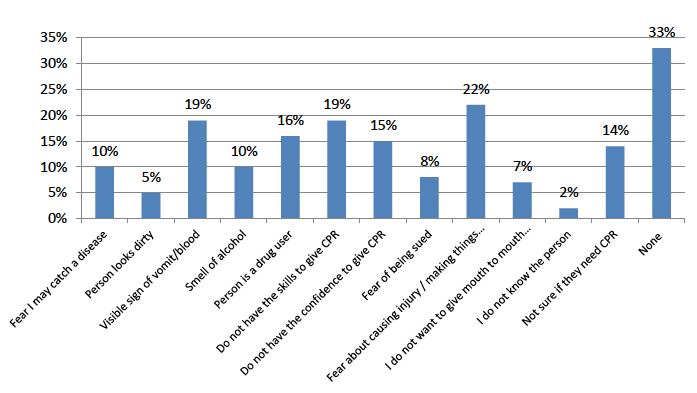
2.2.2 Attitudes towards CPR
Figure 5[10] indicates strong public support for administering CPR – 77% agreed that everyone should be trained in CPR and 83% agreed that they would rather try giving CPR than do nothing. However there was concern around making things worse (44% agreed) or being sued (29% agreed).
Figure 5: Public attitudes towards CPR (n=1027)
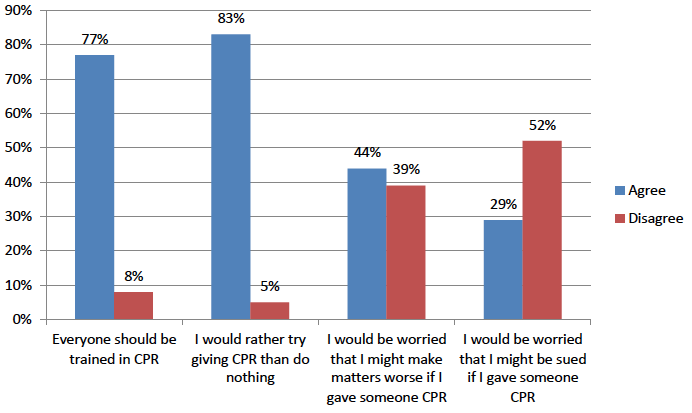
Contact
Email: Connie Smith
There is a problem
Thanks for your feedback